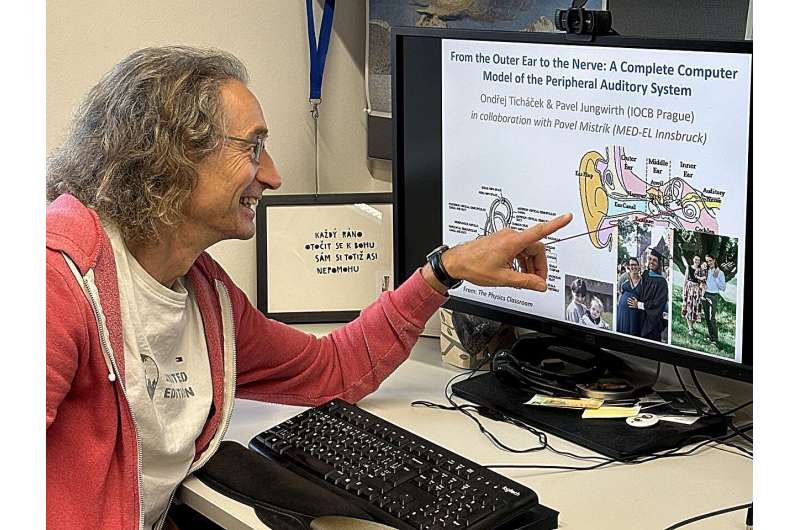This article has been reviewed according to Science X's editorial process and policies. Editors have highlighted the following attributes while ensuring the content's credibility:
fact-checked
trusted source
proofread
A computer model of the ear may help to improve cochlear implants

Professor Pavel Jungwirth and his colleagues from the Institute of Organic Chemistry and Biochemistry of the Czech Academy of Sciences (IOCB Prague) and the cochlear implant company MED-EL, based in Austria have come up with a complete computer model of the ear. It can be used to simulate hearing of mammals, including humans, from the outer ear all the way to the auditory nerve.
The results of their research have been published in the journal Hearing Research recently. This model will not only facilitate further research of the human ear but may also help to improve and better adjust compensation devices for people with hearing impairment, including cochlear implants.
This detailed computational model of the ear, based on the latest knowledge of the physiology and molecular principles of hearing, will make it possible to investigate hearing disorders, regardless of whether they are caused by genetic or external factors. It will also allow experts to learn more about the detailed mechanisms of various forms of hearing impairment and may open ways to improve hearing aids and cochlear implants.
This is also because the present computer model makes it possible to obtain data that are difficult to acquire experimentally. Performing invasive measurements on the human ear is hardly feasible, the only alternative being animal models. This is yet another demonstration of the fact that computer modeling may provide insight into specific problems that cannot be addressed by experimentation and that they can advance our understanding of systems as a whole.
The new computer model of the peripheral auditory system maps in detail how sound is being converted into mechanical vibrations in the middle and inner ear. It then simulates how these vibrations trigger electrical signals in outer and inner hair cells in the cochlea and how these signals get transformed through the action of neurotransmitters into electrical impulses in the cochlear nerve. These signals then get transferred to the central nervous system.
Why did Pavel Jungwirth start research that, at first glance, did not thematically fit into the scientific scope of his research group? "It's a mixture of craziness and personal reasons," he says. "My younger son Matěj has a severe hearing impairment, and I wanted to understand better principles of hearing. Besides, I realized that the transmission of information in the ear is mediated by fluxes of calcium and potassium ions, which is exactly what my research group works on."
Pavel Jungwirth admits that in 2011, when he embarked on the project, he, perhaps naively, believed that it was a job for at most two or three years. It all began when he started to cooperate with Pavel Mistrík from the company MED-EL, which uses computer models in the development of cochlear implants. In the end, the research was brought to a successful completion only after 12 years, thanks to the key contribution of Ondřej Ticháček, according to Jungwirth, an exceptionally talented and hard-working student.
The freshly published computer model of the ear, implemented in the programming language and numerical computing environment MATLAB, is now available to the broad scientific community. This means that it can be used by anyone interested in modeling different types of hearing disorders or searching for ways to better compensate them with hearing aids or cochlear implants.
More information: Ondrej Tichacek et al, From the outer ear to the nerve: A complete computer model of the peripheral auditory system, Hearing Research (2023). DOI: 10.1016/j.heares.2023.108900




















